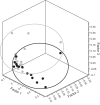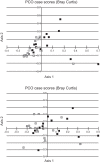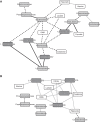Systems biology analysis of omeprazole therapy in cirrhosis demonstrates significant shifts in gut microbiota composition and function - PubMed (original) (raw)
Controlled Clinical Trial
. 2014 Nov 15;307(10):G951-7.
doi: 10.1152/ajpgi.00268.2014. Epub 2014 Sep 25.
I Jane Cox 2, Naga S Betrapally 3, Douglas M Heuman 4, Mitchell L Schubert 4, Maiyuran Ratneswaran 5, Phillip B Hylemon 6, Melanie B White 4, Kalyani Daita 4, Nicole A Noble 4, Masoumeh Sikaroodi 3, Roger Williams 2, Mary M E Crossey 5, Simon D Taylor-Robinson 5, Patrick M Gillevet 3
Affiliations
- PMID: 25258407
- PMCID: PMC4233285
- DOI: 10.1152/ajpgi.00268.2014
Controlled Clinical Trial
Systems biology analysis of omeprazole therapy in cirrhosis demonstrates significant shifts in gut microbiota composition and function
Jasmohan S Bajaj et al. Am J Physiol Gastrointest Liver Physiol. 2014.
Abstract
Proton pump inhibitors (PPI) have been associated with infectious complications in cirrhosis, but their impact on distal gut microbiota composition and function is unclear. We aimed to evaluate changes in stool microbiota composition and function in patients with cirrhosis and healthy controls after omeprazole therapy. Both 15 compensated cirrhotic patients and 15 age-matched controls underwent serum gastrin measurement, stool microbiota profiling with multitagged pyrosequencing, and urinary metabolic profiling with NMR spectroscopy to assess microbial cometabolites before/after a 14-day course of 40 mg/day omeprazole under constant diet conditions. Results before (pre) and after PPI were compared in both groups, compared with baseline by systems biology techniques. Adherence was >95% without changes in diet or MELD (model for end-stage liver disease) score during the study. Serum gastrin concentrations significantly increased after PPI in cirrhosis (pre 38.3 ± 35.8 vs. 115.6 ± 79.3 pg/ml P < 0.0001) and controls (pre 29.9 ± 14.5 vs. 116.0 ± 74.0 pg/ml, P = 0.001). A significant microbiota change was seen in both controls and cirrhosis after omeprazole (QIIME P < 0.0001). Relative Streptococcaceae abundance, normally abundant in saliva, significantly increased postomeprazole in controls (1 vs. 5%) and cirrhosis (0 vs. 9%) and was correlated with serum gastrin levels (r = 0.4, P = 0.005). We found significantly reduced hippurate in cirrhosis vs. controls both pre- and postomeprazole and increased lactate in both groups post vs. preomeprazole, whereas dimethylamine (DMA) decreased in cirrhosis only. On correlation network analysis, significant changes in linkages of bacteria with metabolites (hippurate/DMA/lactate) were found postomeprazole, compared with pre-PPI in cirrhosis patients. In conclusion, omeprazole is associated with a microbiota shift and functional change in the distal gut in patients with compensated cirrhosis that could set the stage for bacterial overgrowth.
Keywords: gastrin; gut barrier; infection; metabolomics; microbiome; proton pump inhibitor.
Copyright © 2014 the American Physiological Society.
Figures
Fig. 1.
Urinary NMR metabolic profiling. Principal component analysis of urinary NMR data sets postomeprazole from controls (gray circles) and cirrhotic patients (black circles) showing clear separation of the groups.
Fig. 2.
Principal component analysis of microbiota before and after omeprazole. Light gray squares, microbiota at baseline; dark gray squares, postomeprazole microbiota. A: significant clustering before omeprazole that changed after omeprazole. B: no clustering before or after omeprazole therapy.
Fig. 3.
Correlation network differences before and after omeprazole. Node colors: light gray, bacterial families; dark gray, unnamed urinary metabolites; white, named urinary metabolites. Edge colors: black dashed, was positive and became negative; black solid, was negative became positive; gray, remained negative but significant change. A: correlation network difference in cirrhotic patients. B: correlation network difference in controls.
Similar articles
- Salivary microbiota reflects changes in gut microbiota in cirrhosis with hepatic encephalopathy.
Bajaj JS, Betrapally NS, Hylemon PB, Heuman DM, Daita K, White MB, Unser A, Thacker LR, Sanyal AJ, Kang DJ, Sikaroodi M, Gillevet PM. Bajaj JS, et al. Hepatology. 2015 Oct;62(4):1260-71. doi: 10.1002/hep.27819. Epub 2015 May 6. Hepatology. 2015. PMID: 25820757 Free PMC article. - Proton Pump Inhibitor Initiation and Withdrawal affects Gut Microbiota and Readmission Risk in Cirrhosis.
Bajaj JS, Acharya C, Fagan A, White MB, Gavis E, Heuman DM, Hylemon PB, Fuchs M, Puri P, Schubert ML, Sanyal AJ, Sterling RK, Stravitz TR, Siddiqui MS, Luketic V, Lee H, Sikaroodi M, Gillevet PM. Bajaj JS, et al. Am J Gastroenterol. 2018 Aug;113(8):1177-1186. doi: 10.1038/s41395-018-0085-9. Epub 2018 Jun 6. Am J Gastroenterol. 2018. PMID: 29872220 - The Proton Pump Inhibitor Omeprazole Does Not Promote Clostridioides difficile Colonization in a Murine Model.
Tomkovich S, Lesniak NA, Li Y, Bishop L, Fitzgerald MJ, Schloss PD. Tomkovich S, et al. mSphere. 2019 Nov 20;4(6):e00693-19. doi: 10.1128/mSphere.00693-19. mSphere. 2019. PMID: 31748246 Free PMC article. - Gut microbiota-related complications in cirrhosis.
Gómez-Hurtado I, Such J, Sanz Y, Francés R. Gómez-Hurtado I, et al. World J Gastroenterol. 2014 Nov 14;20(42):15624-31. doi: 10.3748/wjg.v20.i42.15624. World J Gastroenterol. 2014. PMID: 25400446 Free PMC article. Review. - Gut microbiota and host metabolism in liver cirrhosis.
Usami M, Miyoshi M, Yamashita H. Usami M, et al. World J Gastroenterol. 2015 Nov 7;21(41):11597-608. doi: 10.3748/wjg.v21.i41.11597. World J Gastroenterol. 2015. PMID: 26556989 Free PMC article. Review.
Cited by
- Salivary microbiota reflects changes in gut microbiota in cirrhosis with hepatic encephalopathy.
Bajaj JS, Betrapally NS, Hylemon PB, Heuman DM, Daita K, White MB, Unser A, Thacker LR, Sanyal AJ, Kang DJ, Sikaroodi M, Gillevet PM. Bajaj JS, et al. Hepatology. 2015 Oct;62(4):1260-71. doi: 10.1002/hep.27819. Epub 2015 May 6. Hepatology. 2015. PMID: 25820757 Free PMC article. - Proton Pump Inhibitor Use and Complications of Cirrhosis Are Linked With Distinct Gut Microbial Bacteriophage and Eukaryotic Viral-Like Particle Signatures in Cirrhosis.
Peña Rodríguez M, Fagan A, Sikaroodi M, Gillevet PM, Bajaj JS. Peña Rodríguez M, et al. Clin Transl Gastroenterol. 2024 Feb 1;15(2):e00659. doi: 10.14309/ctg.0000000000000659. Clin Transl Gastroenterol. 2024. PMID: 37937851 Free PMC article. - The gut microbiome in atherosclerotic cardiovascular disease.
Jie Z, Xia H, Zhong SL, Feng Q, Li S, Liang S, Zhong H, Liu Z, Gao Y, Zhao H, Zhang D, Su Z, Fang Z, Lan Z, Li J, Xiao L, Li J, Li R, Li X, Li F, Ren H, Huang Y, Peng Y, Li G, Wen B, Dong B, Chen JY, Geng QS, Zhang ZW, Yang H, Wang J, Wang J, Zhang X, Madsen L, Brix S, Ning G, Xu X, Liu X, Hou Y, Jia H, He K, Kristiansen K. Jie Z, et al. Nat Commun. 2017 Oct 10;8(1):845. doi: 10.1038/s41467-017-00900-1. Nat Commun. 2017. PMID: 29018189 Free PMC article. - Gastric acid suppression promotes alcoholic liver disease by inducing overgrowth of intestinal Enterococcus.
Llorente C, Jepsen P, Inamine T, Wang L, Bluemel S, Wang HJ, Loomba R, Bajaj JS, Schubert ML, Sikaroodi M, Gillevet PM, Xu J, Kisseleva T, Ho SB, DePew J, Du X, Sørensen HT, Vilstrup H, Nelson KE, Brenner DA, Fouts DE, Schnabl B. Llorente C, et al. Nat Commun. 2017 Oct 16;8(1):837. doi: 10.1038/s41467-017-00796-x. Nat Commun. 2017. PMID: 29038503 Free PMC article. - The human laryngeal microbiome: effects of cigarette smoke and reflux.
Jetté ME, Dill-McFarland KA, Hanshew AS, Suen G, Thibeault SL. Jetté ME, et al. Sci Rep. 2016 Oct 24;6:35882. doi: 10.1038/srep35882. Sci Rep. 2016. PMID: 27775059 Free PMC article.
References
- Amir I, Konikoff FM, Oppenheim M, Gophna U, Half EE. Gastric microbiota is altered in oesophagitis and Barrett's oesophagus and further modified by proton pump inhibitors. Environ Microbiol 16: 2905–2914, 2014. - PubMed
- Bajaj JS, Gillevet PM, Patel NR, Ahluwalia V, Ridlon JM, Kettenmann B, Schubert CM, Sikaroodi M, Heuman DM, Crossey MM, Bell DE, Hylemon PB, Fatouros PP, Taylor-Robinson SD. A longitudinal systems biology analysis of lactulose withdrawal in hepatic encephalopathy. Metab Brain Dis 27: 205–215, 2012. - PubMed
- Bajaj JS, Hylemon PB, Ridlon JM, Heuman DM, Daita K, White MB, Monteith P, Noble NA, Sikaroodi M, Gillevet PM. Colonic mucosal microbiome differs from stool microbiome in cirrhosis and hepatic encephalopathy and is linked to cognition and inflammation. Am J Physiol Gastrointest Liver Physiol 303: G675–G685, 2012. - PMC - PubMed
- Bajaj JS, O'Leary JG, Reddy KR, Wong F, Olson JC, Subramanian RM, Brown G, Noble NA, Thacker LR, Kamath PS, Nacseld Second infections independently increase mortality in hospitalized patients with cirrhosis: the North American consortium for the study of end-stage liver disease (NACSELD) experience. Hepatology 56: 2328–2335, 2012. - PMC - PubMed
Publication types
MeSH terms
Substances
Grants and funding
- R01 AA020203/AA/NIAAA NIH HHS/United States
- R01 DK087913/DK/NIDDK NIH HHS/United States
- R01DK087913/DK/NIDDK NIH HHS/United States
- R01AA020203/AA/NIAAA NIH HHS/United States
LinkOut - more resources
Full Text Sources
Other Literature Sources
Medical


